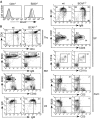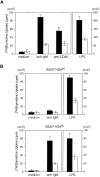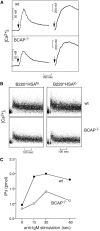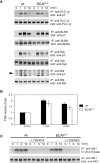Essential immunoregulatory role for BCAP in B cell development and function
- PMID: 11877477
- PMCID: PMC2193770
- DOI: 10.1084/jem.20011751
Essential immunoregulatory role for BCAP in B cell development and function
Abstract
BCAP was recently cloned as a binding molecule to phosphoinositide 3-kinase (PI3K). To investigate the role of BCAP, mutant mice deficient in BCAP were generated. While BCAP-deficient mice are viable, they have decreased numbers of mature B cells and B1 B cell deficiency. The mice produce lower titers of serum immunoglobulin (Ig)M and IgG3, and mount attenuated responses to T cell--independent type II antigen. Upon B cell receptor cross-linking, BCAP-deficient B cells exhibit reduced Ca(2+) mobilization and poor proliferative responses. These findings demonstrate that BCAP plays a pivotal immunoregulatory role in B cell development and humoral immune responses.
Figures







Similar articles
-
[Immunoregulatory role for BCAP in B cell development and function].Tanpakushitsu Kakusan Koso. 2002 Dec;47(16 Suppl):2242-7. Tanpakushitsu Kakusan Koso. 2002. PMID: 12518443 Review. Japanese. No abstract available.
-
Phospholipase Cgamma2 is essential in the functions of B cell and several Fc receptors.Immunity. 2000 Jul;13(1):25-35. doi: 10.1016/s1074-7613(00)00005-4. Immunity. 2000. PMID: 10933392
-
Contribution of BCAP to maintenance of mature B cells through c-Rel.Nat Immunol. 2003 Aug;4(8):780-6. doi: 10.1038/ni949. Epub 2003 Jun 29. Nat Immunol. 2003. PMID: 12833156
-
Regulation of phospholipase C-gamma2 and phosphoinositide 3-kinase pathways by adaptor proteins in B lymphocytes.Int Rev Immunol. 2001;20(6):697-711. doi: 10.3109/08830180109045586. Int Rev Immunol. 2001. PMID: 11913946 Review.
-
Immunoglobulin-mediated signal transduction in B cells from CD45-deficient mice.J Exp Med. 1996 Jan 1;183(1):329-34. doi: 10.1084/jem.183.1.329. J Exp Med. 1996. PMID: 8551241 Free PMC article.
Cited by
-
TLR signaling adapter BCAP regulates inflammatory to reparatory macrophage transition by promoting histone lactylation.Proc Natl Acad Sci U S A. 2020 Dec 1;117(48):30628-30638. doi: 10.1073/pnas.2009778117. Epub 2020 Nov 16. Proc Natl Acad Sci U S A. 2020. PMID: 33199625 Free PMC article.
-
Basal B cell receptor-directed phosphatidylinositol 3-kinase signaling turns off RAGs and promotes B cell-positive selection.J Immunol. 2007 May 15;178(10):6332-41. doi: 10.4049/jimmunol.178.10.6332. J Immunol. 2007. PMID: 17475862 Free PMC article.
-
Genome-wide association study for atopy and allergic rhinitis in a Singapore Chinese population.PLoS One. 2011;6(5):e19719. doi: 10.1371/journal.pone.0019719. Epub 2011 May 20. PLoS One. 2011. PMID: 21625490 Free PMC article.
-
Nck-mediated recruitment of BCAP to the BCR regulates the PI(3)K-Akt pathway in B cells.Nat Immunol. 2013 Sep;14(9):966-75. doi: 10.1038/ni.2685. Epub 2013 Aug 4. Nat Immunol. 2013. PMID: 23913047
-
The first whole genome and transcriptome of the cinereous vulture reveals adaptation in the gastric and immune defense systems and possible convergent evolution between the Old and New World vultures.Genome Biol. 2015 Oct 21;16:215. doi: 10.1186/s13059-015-0780-4. Genome Biol. 2015. PMID: 26486310 Free PMC article.
References
-
- Meffre, E., R. Casellas, and M.C. Nussenzweig. 2000. Antibody regulation of B cell development. Nat. Immunol. 1:379–385. - PubMed
-
- Hardy, R.R., and K. Hayakawa. 2001. B cell development pathways. Annu. Rev. Immunol. 19:595–621. - PubMed
-
- Benschop, R.J., and J.C. Cambier. 1999. B cell development: signal transduction by antigen receptors and their surrogates. Curr. Opin. Immunol. 11:143–151. - PubMed
-
- Rajewsky, K. 1996. Clonal selection and learning in the antibody system. Nature. 381:751–758. - PubMed
Publication types
MeSH terms
Substances
LinkOut - more resources
Full Text Sources
Other Literature Sources
Molecular Biology Databases
Miscellaneous

